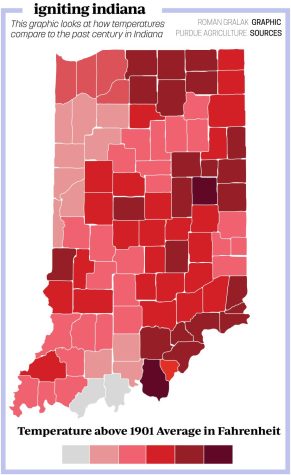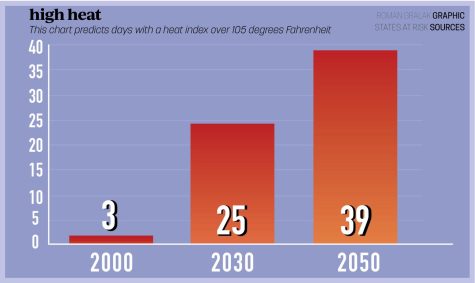Last summer, the Indiana State Board of Education approved new science standards. The old standards earned a “D” grade in a 2020 study of climate change in state science standards conducted by the National Center for Science Education and the Texas Freedom Network Education Fund. These new changes come on the heels of a recent estimate from the Yale Program on Climate Change Communication. In their report, nearly three quarters of Indiana citizens said they agreed that the amount of climate change knowledge being taught in schools should increase. The new standards require high school students to “analyze geoscience data and the results from global climate models to make an evidence-based forecast of the current rate of global or regional climate change and associated future impacts to Earth systems.”

Sophomore Katherine Ke, who plans to take AP Environmental Science, said, “These standards are necessary, in my opinion, because there are a lot of threats to climate change that include rising temperatures and sea levels and also more severe weather more frequently and a possible ecosystem collapse.”
Kara House, AP Environmental Science and Earth and Space Science teacher, said although Indiana is adopting these standards, it doesn’t affect AP Environmental Science as much as it affects her Earth science class.
House said, “So (in) my AP Environmental Science class, we do already have climate change standards and it’s just that they’re not anything new, so we’ve had them for quite a while. For the Earth science, we had a lot of standards that were just based on climate and climate science, but there’s a few more now that emphasize climate change and there’s some that emphasize a lot of the anthropogenic things behind climate change, so it’ll be a little bit newer for that particular unit that we do. We have a lot (of material) about how humans are involved in the changing of the Earth and things like that.”
Sophomore Maxwell Gootee, who said he also plans to take AP Environmental Science, said although these standards are necessary, implementing them in a high school setting is not what he recommends.
Gootee said, “These standards are important and necessary, but they should not be taught in a high school setting. Limited scope of knowledge and limited time may heed people from actually learning these skills, so it doesn’t make sense to teach them to high schoolers especially when most students take classes like (AP Environmental Science) just for a science credit and generally forget the material.”

Despite these concerns, Gootee said he agreed with Ke that not enough information is currently being taught on climate change. Ke said that she hopes with these standards, the curriculum will help students have a better understanding of human-induced climate change.
Ke said, “I’m actually really excited to go more in-depth and learn more about the reasoning behind human-caused climate change and also learning more about the steps I can take to reduce harmful environmental behaviors individually and how to educate others in the community and trying to promote climate change reforms.”
House said she agreed with Ke and said she hopes students will feel more connected with our climate with the new standards in place.
She said, “I like that the students can feel a little more connected to what we’re actually doing, whereas sometimes with Earth science, where (students learn about climate) over millions of years, it doesn’t seem all that personal, it doesn’t seem to influence their life that much so I actually like the fact that we can talk about how the actions of the students actually can make an impact on the Earth and then how their lives are going to be affected by the Earth in turn, so I’m looking forward to it.”































![What happened to theater etiquette? [opinion]](https://hilite.org/wp-content/uploads/2025/04/Entertainment-Perspective-Cover-1200x471.jpg)














































![Review: “The Immortal Soul Salvage Yard:” A criminally underrated poetry collection [MUSE]](https://hilite.org/wp-content/uploads/2025/03/71cju6TvqmL._AC_UF10001000_QL80_.jpg)
![Review: "Dog Man" is Unapologetically Chaotic [MUSE]](https://hilite.org/wp-content/uploads/2025/03/dogman-1200x700.jpg)
![Review: "Ne Zha 2": The WeChat family reunion I didn’t know I needed [MUSE]](https://hilite.org/wp-content/uploads/2025/03/unnamed-4.png)
![Review in Print: Maripaz Villar brings a delightfully unique style to the world of WEBTOON [MUSE]](https://hilite.org/wp-content/uploads/2023/12/maripazcover-1200x960.jpg)
![Review: “The Sword of Kaigen” is a masterpiece [MUSE]](https://hilite.org/wp-content/uploads/2023/11/Screenshot-2023-11-26-201051.png)
![Review: Gateron Oil Kings, great linear switches, okay price [MUSE]](https://hilite.org/wp-content/uploads/2023/11/Screenshot-2023-11-26-200553.png)
![Review: “A Haunting in Venice” is a significant improvement from other Agatha Christie adaptations [MUSE]](https://hilite.org/wp-content/uploads/2023/11/e7ee2938a6d422669771bce6d8088521.jpg)
![Review: A Thanksgiving story from elementary school, still just as interesting [MUSE]](https://hilite.org/wp-content/uploads/2023/11/Screenshot-2023-11-26-195514-987x1200.png)
![Review: "When I Fly Towards You", cute, uplifting youth drama [MUSE]](https://hilite.org/wp-content/uploads/2023/09/When-I-Fly-Towards-You-Chinese-drama.png)
![Postcards from Muse: Hawaii Travel Diary [MUSE]](https://hilite.org/wp-content/uploads/2023/09/My-project-1-1200x1200.jpg)
![Review: "Ladybug & Cat Noir: The Movie," departure from original show [MUSE]](https://hilite.org/wp-content/uploads/2023/09/Ladybug__Cat_Noir_-_The_Movie_poster.jpg)
![Review in Print: "Hidden Love" is the cute, uplifting drama everyone needs [MUSE]](https://hilite.org/wp-content/uploads/2023/09/hiddenlovecover-e1693597208225-1030x1200.png)
![Review in Print: "Heartstopper" is the heartwarming queer romance we all need [MUSE]](https://hilite.org/wp-content/uploads/2023/08/museheartstoppercover-1200x654.png)


